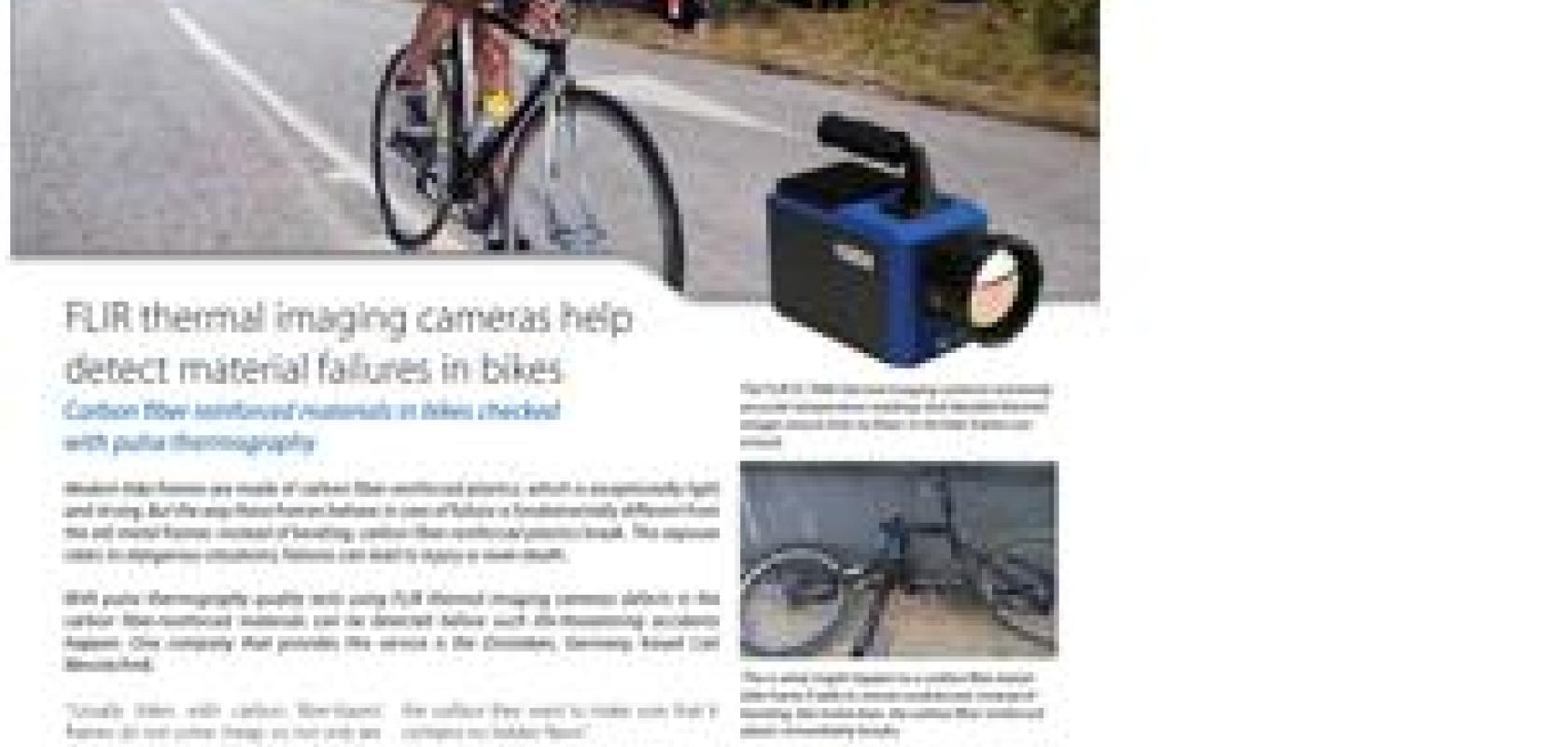Thermal imaging helps detect material failure in bikes

Modern bike frames are made of carbon fibre-reinforced plastics, which is exceptionally light and strong. But the way these frames behave in case of failure is fundamentally different from the old metal frames. Instead of bending, carbon fibre-reinforced plastics break. This exposes riders to dangerous situations; failures can lead to injury or even death.
With pulse thermography quality tests using FLIR thermal imaging cameras defects in the carbon fibre-reinforced materials can be detected before such life-threatening accidents happen. One company that provides this service is Carl Messtechnik, based in Dinslaken, Germany.
'Usually bikes with carbon fibre-based frames do not come cheap, so not only are these tests important for driver safety, they also serve to protect your assets,' explains Volker Carl, pulse thermography specialist and owner of the company.
Checking crashed or second hand bikes
According to Carl his customers have many different reasons for coming to him for these tests. 'Some of them might have had a crash with their bike and want to make sure that this accident has not caused invisible defects. Other clients have bought a second-hand bike and although it looks perfect on the surface they want to make sure that it contains no hidden flaws.'
These flaws in the bike frame can be caused by more than accidents alone. 'Carbon-based frames can be surprisingly vulnerable to specific types of stress. A bike might fall over and hit the edge of the curb for instance. Even if you tighten the roof-rack clamp or derailleur clamp too tightly when you’re preparing your bike for transport, this can cause invisible cracks. On the surface, everything might still look fine, but in reality the bike is damaged and it will only last a couple of days before it breaks.'
‘Invisible damage is dangerous’
Using a bike with such invisible damage can be quite dangerous. 'Imagine you’re descending from a mountain at high speed and suddenly in a bend in the road your bike breaks. That really is a very dangerous situation. Not only can such accidents be prevented by detecting defects beforehand, in most cases it is also possible to repair these defects. Although the repair process is quite complex, it can often result in a bike that is even stronger than the original design.'
In order to find out whether such repairs are necessary, bike owners can have their bikes scanned by Carl’s FLIR thermal imaging camera, using a method called pulse thermography. 'We trigger a thermal impulse and use the FLIR thermal imaging camera to trace the heat flow. Differences in the heat flow can indicate material defects. The thermal data collected with the thermal imaging camera provides a unique insight into the flaws in carbon fibre-reinforced materials.'
FLIR SC7000: ‘Extremely accurate’
The thermal imaging camera used by Carl is the FLIR SC7000 thermal imaging camera. The cooled Indium antimonide (InSb) detector is extremely sensitive (<20mK) and provides high contrast thermal images at a resolution of 640x512 pixels. 'The SC7000 is extremely good for this application, for its accurate temperature readings and detailed thermal images ensure that no flaws are missed.'
Currently Carl is also working on a new setup with a FLIR SC645 thermal imaging camera. 'The FLIR SC645 is slightly less sensitive, but the difference in price and in maintenance cost with the SC7000 will allow me to charge lower fees for the quality tests using the FLIR SC645 thermal imaging camera.'
New type of client
This new setup will open the door for a new type of customer, Carl hopes. 'Currently, my customers are mostly professionals and semi-professionals that use their bikes very often. They really need to be sure that the bike is absolutely safe, so I expect that this type of customer will still prefer the more accurate tests using the FLIR SC7000 thermal imaging camera. But I think that hobbyists that currently refrain from this type of test will be attracted to the quality tests using the FLIR SC645 because of the lower fees.'
The FLIR SC645 thermal imaging camera has an uncooled microbolometer detector that produces thermal images at a resolution of 640 × 480 pixels. With its thermal sensitivity of <50 mK it is less sensitive than the FLIR SC7000 thermal imaging camera, but the fact that it contains an uncooled detector means that it requires virtually no maintenance.
Wide product range
Carl is very happy with FLIR’s product range. 'In my experience there is no thermal imaging camera supplier in the world that has such an extensive range of different types of thermal imaging cameras. From the affordable SC-series to the extremely advanced SC7000 thermal imaging cameras, FLIR has exactly the camera to fit anyone's needs.'

